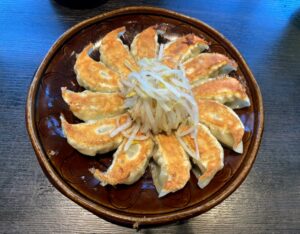The History of Gyoza

Gyoza holds a significant place in Japanese cuisine, featuring prominently in daily meals as well as special events and celebrations. Originally from China, gyoza has undergone a unique evolution in Japan, becoming a beloved and iconic dish. This article explores the history of gyoza, its evolution, and its role in Japanese food culture.
1. The Origins of Gyoza

The origins of gyoza can be traced back to ancient China, where it was traditionally enjoyed as steamed dumplings called zhēngjiǎo. Gyoza was introduced to Japan in the early 20th century through travelers and immigrants. However, it wasn’t until after World War II that it gained widespread popularity. Returning soldiers brought back recipes and techniques from China, adapting them to Japan’s local ingredients and post-war environment.
This adaptation gave rise to Japan’s signature yaki-gyoza, where gyoza is pan-fried on one side to create a crispy bottom and then steamed for a soft, juicy texture. This innovative cooking method helped establish gyoza as a unique and widely loved dish in Japan.
2. Post-War Expansion of Gyoza Culture

After the war, gyoza became a staple of Japanese home cooking. Making gyoza at home became a communal activity, with families gathering to wrap and cook gyoza together. These “gyoza parties” fostered a sense of togetherness and joy, turning the dish into a symbol of familial bonds.
The filling of gyoza also diversified during this time. While the classic combination of pork, cabbage, garlic, and ginger remained popular, variations featuring ingredients like shrimp, shiso, and kimchi emerged, showcasing regional creativity.
3. Regional Gyoza Specialties in Japan

Across Japan, regional variations of gyoza reflect local flavors and traditions:
- Utsunomiya: Known as the “City of Gyoza,” Utsunomiya offers an array of gyoza styles and hosts an annual gyoza festival.
- Hamamatsu: Famous for its circular presentation, Hamamatsu gyoza is arranged in a ring with bean sprouts in the center, creating a unique and visually appealing dish.
- Kyoto: Featuring a milder flavor with less garlic, Kyoto’s gyoza embodies the city’s refined culinary traditions.
4. Modern Gyoza Culture

Today, gyoza is not only a beloved homemade dish but also widely available at supermarkets, convenience stores, and restaurants. Frozen gyoza has advanced significantly, allowing anyone to enjoy restaurant-quality dumplings at home. Specialized gyoza restaurants and high-end eateries have also emerged, offering premium gyoza experiences.
In recent years, visually appealing “Instagrammable” gyoza with vibrant colors or creative plating have gained popularity, catering to the social media generation. Additionally, cooking classes for tourists often include gyoza-making workshops, offering hands-on experiences and a deeper appreciation of the dish.
5. The Future of Gyoza

As health consciousness and environmental awareness continue to grow, new trends such as organic and eco-friendly gyoza are likely to emerge. Food trucks serving freshly made gyoza and further innovations in frozen gyoza could make the dish even more accessible to busy individuals.
Gyoza is more than just a meal—it represents family connections, heartfelt hospitality, and the rich culinary traditions of Japan. As gyoza culture continues to evolve, it will undoubtedly remain an enduring symbol of Japan’s creativity and warmth, passed down to future generations.
